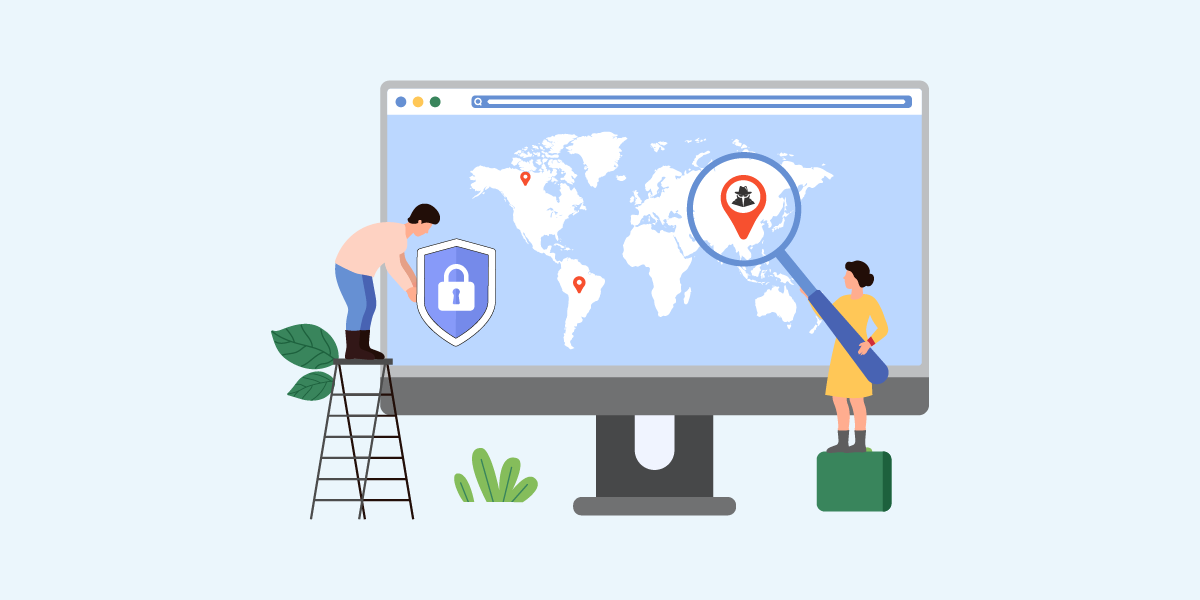
Cyber-attacks are becoming more frequent and sophisticated. Seems like almost every week you hear about data breaches at big organizations and companies getting hit by ransomware. According to a report by Cybersecurity Ventures, global cybercrime costs are projected to reach $10.5 trillion annually by 2025.
IP Geolocation: How to Mitigate Cyber Threats
One of the most effective methods for identifying and mitigating cyber-attacks is through the use of IP geolocation. IP geolocation helps businesses to identify suspicious activities by unveiling the geographical origin of IP addresses.
It plays a critical role in preventing unauthorized access or malicious attacks. Companies implementing IP-based threat detection have experienced significant reductions in security breaches. By leveraging IP geolocation, organizations can enhance their defense mechanisms, protect sensitive data, and stay one step ahead of cybercriminals.
Key Ways to Use IP Geolocation
Below, we’ll explore the 9 key ways to utilize IP geolocation in order to prevent cyber-attacks:
Blocking Traffic from High-Risk Locations
- IP-based Blocking: Use IP geolocation to block traffic from countries or regions known for originating a high number of cyberattacks. If your organization does not operate in specific regions, consider restricting access to your network from those areas.
- Geo-IP Filtering: Implement geo-IP filtering on your firewall or intrusion detection system (IDS). Automatically deny access to requests from suspicious regions or specific IP ranges, preventing potential attacks.
Geolocation-Based Authentication
- Multi-Factor Authentication (MFA): Combine geolocation with MFA . If a user’s login request comes from an unusual location (e.g., a new country or city), require additional authentication steps, like sending a verification code to their phone.
- Suspicious Login Detection: Monitor login attempts based on IP geolocation data. If a user normally logs in from one region and suddenly tries to log in from a different country, flag or block the attempt until it is verified. E.g., if a server in the United States is suddenly being accessed from a country known for cybercrime, it could be a red flag.
Geo-Fencing Critical Systems
- Network Segmentation: Use IP geolocation to create virtual boundaries (geo-fencing) around sensitive systems. Allow only IP addresses from trusted locations to access critical infrastructure or databases, ensuring that users can only access resources from authorized locations.
- Whitelisting Known IPs: Allow access only from specific geographical locations where your employees, customers, or partners are located. This reduces the attack surface by denying access to IPs from outside of those locations.
Monitoring for Suspicious Activity
- Real-Time IP Monitoring: Monitor the geolocation of incoming IP addresses in real-time. Anomalous access patterns, such as multiple failed login attempts from different regions, can indicate brute force attacks or other malicious activities.
- Threat Intelligence Feeds: Use IP threat intelligence feeds that track known malicious IP addresses by region. Integrate this data into your security tools to automatically block traffic from those addresses.
Location-Specific Rate Limiting
- Throttling Suspicious Regions: Apply rate-limiting rules based on geolocation. E.g., limit the number of requests allowed from IPs in high-risk regions, which can slow down or mitigate Distributed Denial of Service (DDoS) attacks.
Implementing VPN Restrictions
- VPN and Proxy Detection: Some attackers use VPNs or proxies to mask their real location. IP geolocation tools can detect and block IPs from known VPN providers or anonymizers, ensuring you don’t allow malicious actors to bypass location-based restrictions.
- Whitelist Company VPNs: If your organization uses a VPN for remote access, ensure that only the company VPN IP addresses are whitelisted, and block all others attempting to access your internal systems.
IP Reputation Management
- Automated IP Reputation: Use tools that assign risk scores to IP addresses based on past behavior and geolocation. High-risk IPs, even from trusted regions, can be automatically flagged for additional verification or blocked entirely.
Geolocation for Incident Response
- Investigating Cyber Incidents: Use IP geolocation data to track the source of cyberattacks. Correlate IP addresses used in attacks with their geographic locations to gain insights into potential threat actors.
- Forensics and Reporting: After detecting cyber-attacks, IP geolocation can help to build a timeline of events by identifying where the attacks originated from, assisting in incident response and threat hunting. Learn about network forensic.
Fraud Prevention
- Detecting Fraudulent Transactions: By analyzing the geolocation of transaction data, businesses can identify fraudulent activity, such as orders placed from unusual locations or multiple accounts associated with the same IP address.
- IP Location Anomaly Detection: Detect any possible anomaly in real-time. Merchants can identify any potential IP location anomaly instantly – if an order’s IP geolocation deviates from the normal pattern based on past sales records. Take preventive measures, such as adding suspicious IPs to a blacklist or watchlist, after identifying an abnormal IP location.
- Preventing Chargebacks: Geolocation can help prevent chargebacks by verifying the location of the customer’s device against the billing address.
Tools for IP Geolocation Security
- Introducing IP2Location and IP2Proxy: Services that offers geolocation tools specifically designed for cybersecurity purposes. IP geolocation and proxy detection data can be integrated with firewalls, web servers, and security tools to block or monitor based on location. There are also options for performing IP lookup and proxy detection in real-time using the IP2Location and IP2Proxy API services.
Conclusion
IP geolocation is a valuable tool for enhancing cybersecurity by providing insights into the geographic location of internet traffic. Incorporating IP geolocation into your cybersecurity strategy, adds an additional layer of protection against a wide variety of threats. Combine with other security measures like firewalls, encryption, and user authentication for maximum protection against cyber threats.
THE POWER OF IP GEOLOCATION
Find a solution that fits.
